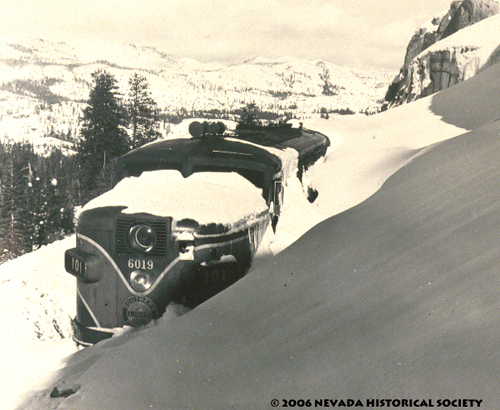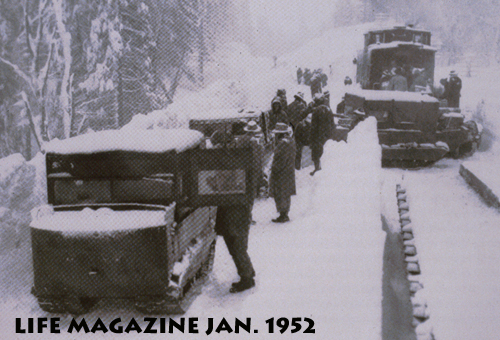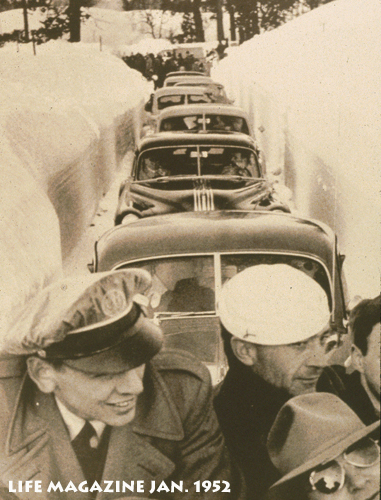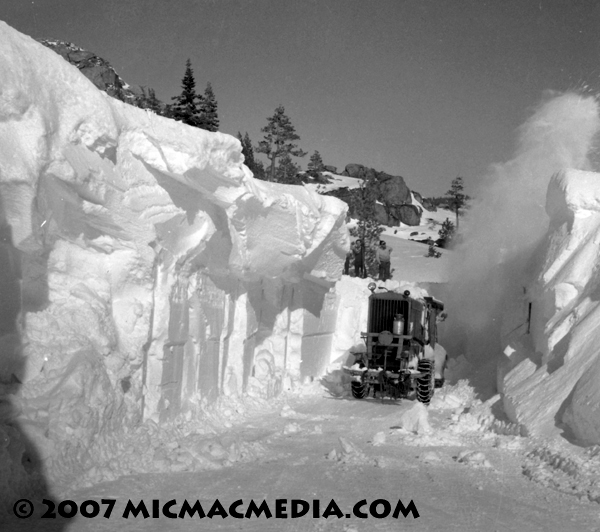|
Tahoe Nugget #106:
Snowbound Train - 1952
February 28, 2007
The recent winter storms closed down Interstate 80 between California and Nevada for the better part of two days. A huge mudslide today has blocked Highway 50, which links South Lake Tahoe with Sacramento —
Caltrans estimates the closure will probably last a couple of days. The havoc on the roads is a stark reminder that despite "all weather highways" and an armada of snow removal equipment, the Storm King
can still strike crippling blows in the Sierra Nevada.
Fifty-five years ago, a major blizzard in January 1952 shut down Interstate 40 (precursor to I-80) for 30 days straight. Not only was this vital
transcontinental highway closed for a month, but a luxury streamliner train became snowbound in the mountains with 226 passengers and crew onboard. The event was national news at the time.
The City of San
Francisco was the pride of the Southern Pacific fleet. At its inauguration on Jan. 2, 1938, the state of the art passenger train was deemed the "world's most superlative train." She consisted of deluxe
sleepers and coaches loaded with amenities, with motive power supplied by six 900-horsepower engines. A technological marvel in engineering, she was proclaimed the "the largest, fastest, most beautiful,
powerful, and luxurious streamliner ever designed." The elegant $2 million train took transcontinental travel to a whole new level in speed and comfort, making five round trips each month between Oakland and
Chicago, hurtling the distance between the Windy City and the Golden Gate in less than 40 hours and at speeds exceeding 100 mph.
On Sunday, January 13, 1952, SP's finest streamliner rammed a deep snowslide
east of Yuba Gap, about 20 miles west of Donner Pass. When engineers threw the train into to reverse to escape, the steel wheels slipped on the icy track. Nobody panicked. After all, the luxury train was more
powerful and better equipped than any on the line. Among the 196 travelers on board were representatives bound for a Republican National Committee meeting in San Francisco and soldiers bound for the Korean War. No
one really expected to be there very long.
Their laissez-faire attitude turned to anger when they were still snowbound 24 hours later. The wind was fierce, howling at speeds in excess of 90 mph and drifts
towered 20 to 30 feet. Many feared it would be just a matter of time before another avalanche would shove the entire train into the steep ravine below. Mid-day Monday, 30 hours into their ordeal and with no rescue
in sight, the supply of diesel fuel ran out. When the power quit, the passenger compartments were pitched into a cold eerie darkness.
Even as the blizzard raged on, SP rescue trains were inching their way
closer from both east and west toward the stranded streamliner. One train carried dogsled teams, while the Sixth Army trucked in Weasels (over-snow track vehicles) and soldiers trained in winter survival. Military
doctors and nurses were rushed to the likely rescue points. During a brief lull in the storm, a Coast Guard helicopter managed to drop medical supplies and food.
At one point, an avalanche struck a rotary
snowplow manned by engineer Rolland Raymond of Sacramento and he was killed: another rescuer, 36-year-old Jay Gold, died of a heart attack from his exertions.
When the deadly storm finally broke on January
16, relief parties rushed in for the rescue. The cold and weary passengers hobbled to safety along the tracks while the sick and weak were tobogganed or carried on stretchers. Miraculously, all 226 passengers and
crew survived their three-day ordeal on the snowbound train.
The dangerous rescue was staged during a vicious blizzard; nearly 13 feet of snow blasted the region that week. The storms of '52 dumped nearly 65
feet of snow on Donner Summit and the snowpack reached 26 feet deep, the greatest depth ever recorded there.
Photo #1: Lead locomotives buried in deep Sierra snow.
Photo #2: Army Weasels
transported to rescue staging area on flatbed railroad cars.
Photo #3: Emergency access road bulldozed for rescue automobiles. Several soldiers on their way to the Korean War expressed satisfaction at missing
their ship-out date and an extended furlough in San Francisco.
Photo #4: Rotary snowplow clearing Interstate 40 in late January 1952. Dynamite was also used to loosen the packed snow. Photo by Robert Gerdel.




|






